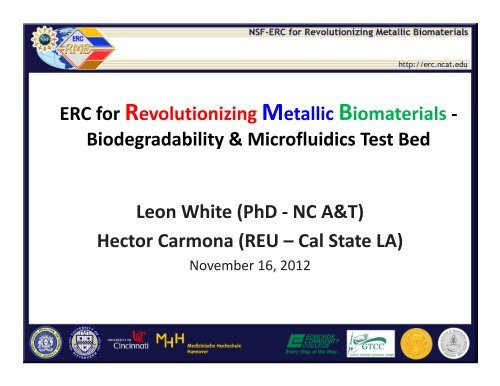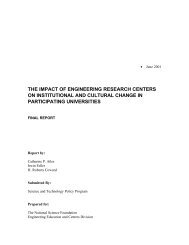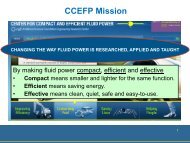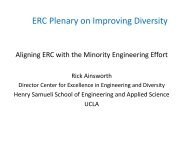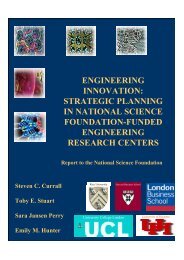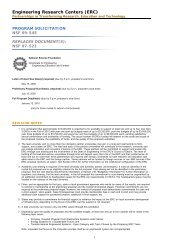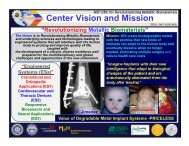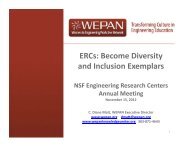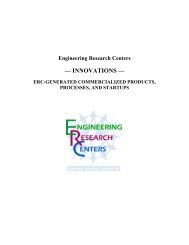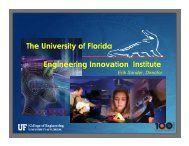Hector Carmona
Hector Carmona
Hector Carmona
You also want an ePaper? Increase the reach of your titles
YUMPU automatically turns print PDFs into web optimized ePapers that Google loves.
ERC for Revolutionizing Metallic Biomaterials ‐<br />
Biodegradability & Microfluidics Test Bed<br />
Leon White (PhD ‐ NC A&T)<br />
<strong>Hector</strong> <strong>Carmona</strong> (REU – Cal State LA)<br />
November 16, 2012
TEAM<br />
Leon White: PhD Student – North Carolina A&T State University<br />
• Macro level corrosion testing of Mg alloys<br />
• Development of Coatings for Mg alloys<br />
<strong>Hector</strong> <strong>Carmona</strong>: REU – California State University, Los Angeles<br />
• Microfluidic chip fabrication<br />
• Micro-level corrosion study<br />
Aditya Abadve: High School Student – Greensboro Day School<br />
• Corrosion of Mg alloy in Simulated Body Fluid<br />
• Hydrogen Evolution Tests<br />
Aebeyo Abraha: RET- Smith High School Greensboro, NC<br />
• Studied how different aqueous solutions affect the corrosion of Mg alloys
Center Vision<br />
“Revolutionizing Metallic Biomaterials”<br />
Research Innovation (Technology/ Devices)<br />
The Vision is to Revolutionizing Metallic Biomaterials and underlying<br />
sciences and technologies leading to engineered systems that will interface<br />
with the human body to prolong and improve quality of life<br />
Coupled with the development of a vibrant, diverse workforce wellprepared<br />
for the multidisciplinary and global challenges and opportunities<br />
of the new millennium.<br />
Workforce of Tomorrow (Educating Next Generation)
NSF-ERC for Revolutionizing Metallic Biomaterials<br />
National Priority to become the Global Leader<br />
Craniofacial and Orthopedic Applications<br />
Cardiovascular Devices<br />
Responsive Biosensors<br />
“Imagine Implants with their own intelligence that<br />
adapt to biological changes of the patient and are<br />
automatically eliminated from the body after healing”<br />
TRAUMA Medical spending: Close to $250 billion<br />
mini plate surgeries led to infection . Ti plate fixations need to be<br />
removed due to complications, infections, pain<br />
stents are difficult to remove and additional stents must be<br />
inserted (elicit an immune response that can lead to the growth of<br />
scar tissue and the formation of blood clots)<br />
Value of regenerative implants, Degradable metal anchors,<br />
screws, plates, stents and drug eluting stents, staples,<br />
sutures, sternal wires, and meshes<br />
PRICELESS<br />
Cleft Lip<br />
Malformations<br />
Complex fractures of the Tibia<br />
and Femur: Need for Resorbable<br />
Fixation Plates, Pins and Screws<br />
Before After
Bone<br />
Fracture<br />
The Teams’ Dream<br />
Screws, pins,<br />
plates and etc
Corrosion – Complex Interplay<br />
“Corrosion is deterioration of metal and is caused by the<br />
metal’s reaction with environment.” (Joe H. Payer).<br />
3. 주요 설문 내용<br />
1. Metal<br />
Metal’s Properties<br />
(Electrode’s Potential)<br />
3. Interface dynamics<br />
Electrochemical reaction kinetics<br />
2. Environment<br />
Complex In Vivo Environment
Biodegradability Test Bed<br />
MACRO Scale MICRO Scale<br />
Various Mg Alloys Used<br />
Microfluidics Channels
Optical Images (10 day Immersion test)<br />
Same Alloy, Different Immersion Solution
MicroCT Images: Corrosion<br />
Corrosion propagation<br />
Hydrogen evolution, stress generation, and crack propagation<br />
Corrosion product formation in pitting area
Microfluidics Approach<br />
• Must understand the microenvironment and role of grain<br />
boundaries and alloy elements in corrosion.<br />
• Behavior and precise control and manipulation of fluids<br />
that are geometrically constrained in micro‐channels.<br />
• Develop a 4 channel magnesium gradient into different<br />
cell culture chambers and observe their behavior.<br />
• This allows us to test 4 different magnesium<br />
concentrations using only nano‐liters of fluid and cell<br />
cultures.
Dynamic cell culture<br />
Microfluidics<br />
• Develop novel micro-devices which can study cell/tissue<br />
behavior on corroding Mg surface<br />
• This device can provide spatiotemporal behavior of<br />
cell/tissue under the corrosion controlled parameters<br />
including surface area, volume of media, surface to<br />
volume ratio, pH change, osmolality, Mg ion concentration,<br />
hydrogen gas evolution, surface passivation.
Inlet<br />
Syringe pump<br />
Velocity<br />
Profile(cm/s)<br />
Q=500e-6L/min<br />
Microfluidic chip<br />
Outlet<br />
COMSOL simulation<br />
Microfluidics Approach<br />
Mg<br />
Cross-section<br />
Mg alloy<br />
PDMS-PDMS bonding<br />
- Microfluidic chips are successfully fabricated<br />
- Platelet solution flow<br />
- More severe corrosion in flow environment<br />
- Less platelet adhesion on toxol-coated surface<br />
AZ31B AZ31B<br />
Static Incubation (1hr) (1hr, 50 µL/min)<br />
- Platelet adhesion test using platelet-rich plasma<br />
- Sodium Citrate (3.2 %)
Coating Development –A Possible Answer<br />
Immersion Test
6.35mm<br />
2mm<br />
In Vivo Testing
Strategic Plan of the ERC‐RMB
•16‐year teaching experience at Smith High School<br />
•Selected for US Dept of State Teachers for Global<br />
Curricula (TGC) Program<br />
•Only 65 teachers selected for 2012 TGC program<br />
•Visited India in July 2012 as State Dept Scholar<br />
Aebeyo & Aditya<br />
•Young Scholars Participant 2011 & 2012<br />
•Selected for Center for Creative Leadership<br />
Program<br />
•Applying for top Universities in Biomedical<br />
Engineering
THANK YOU


